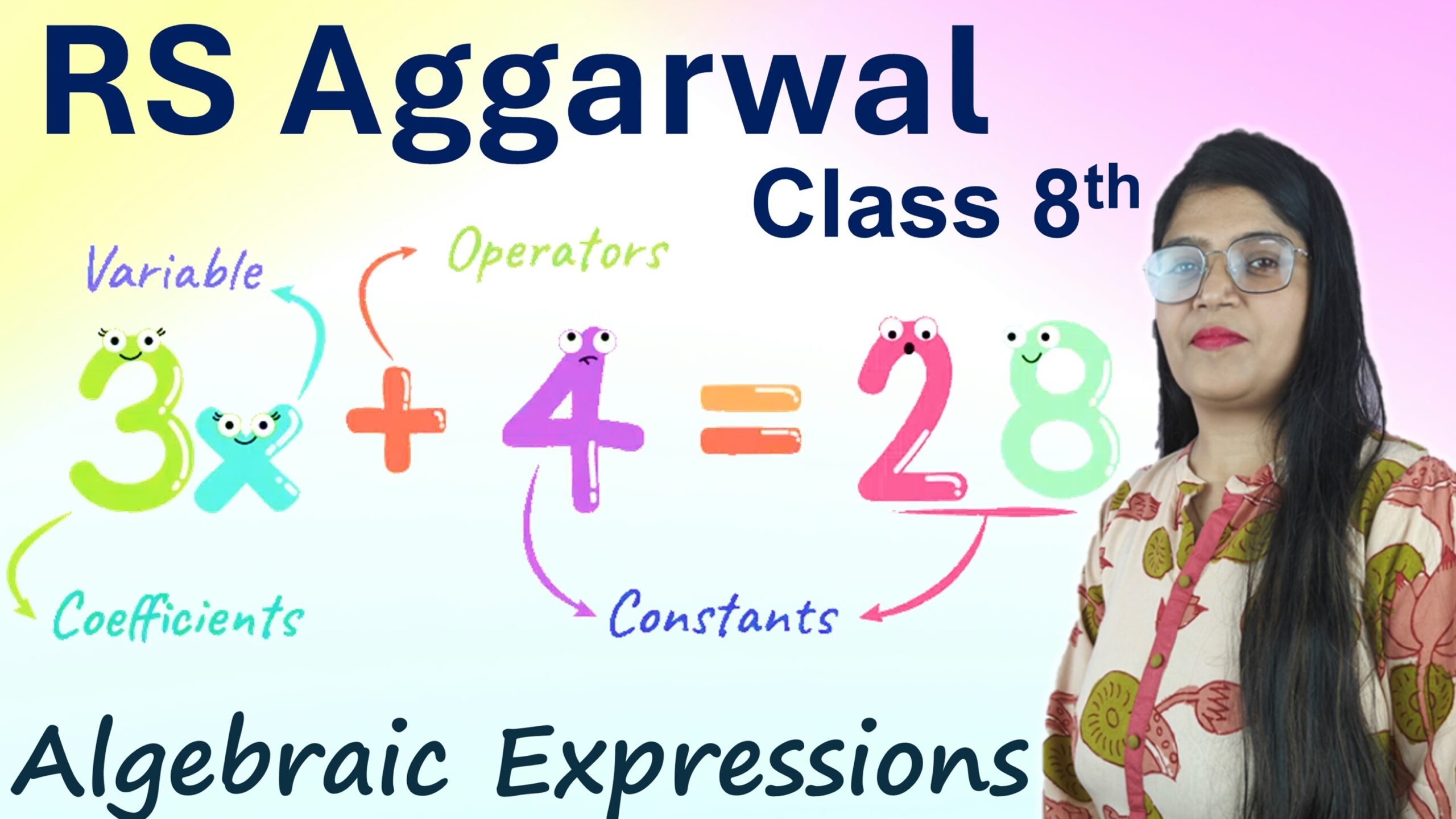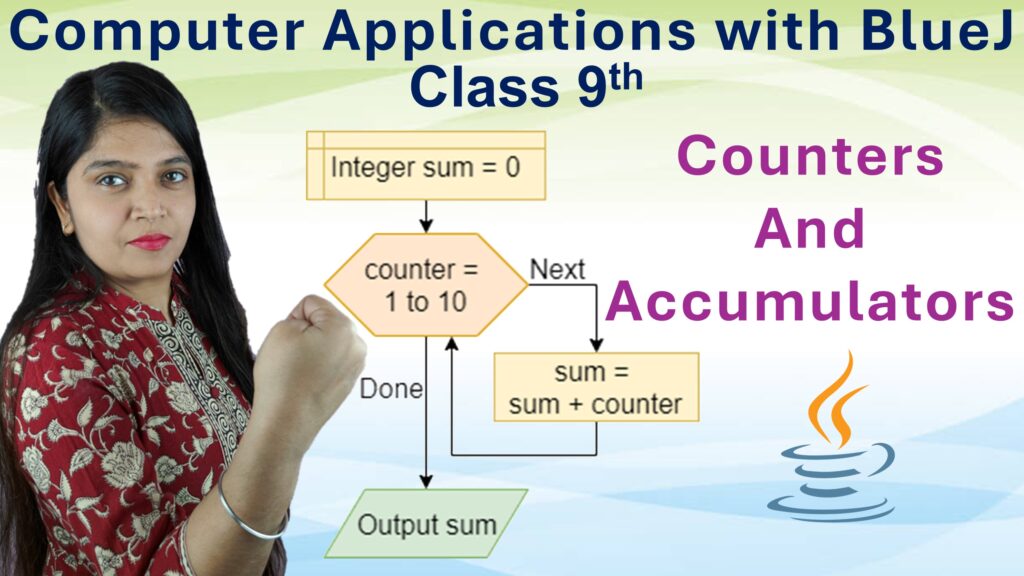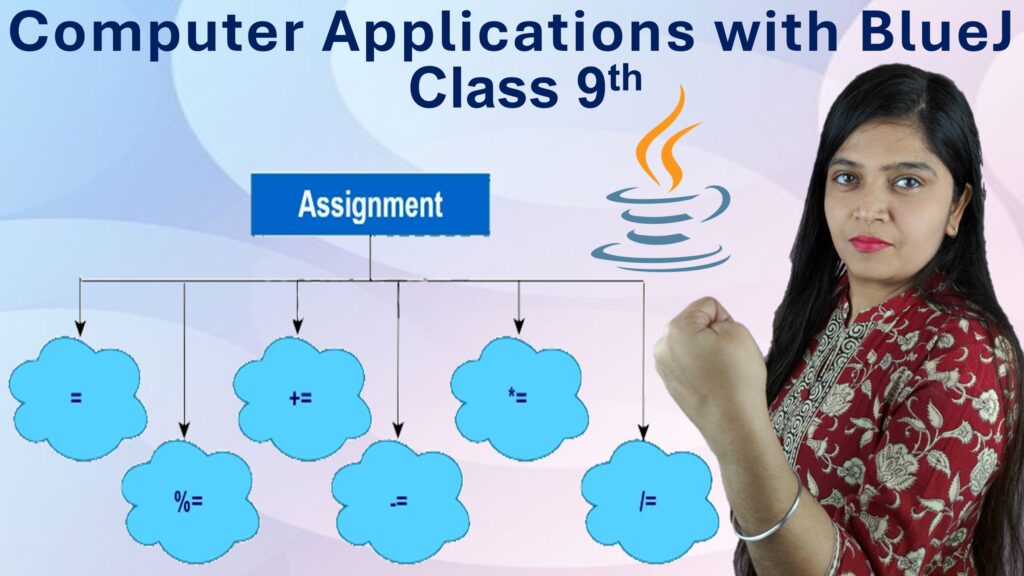Exercise: 12-B
Q1: Add:
i. \(2ab,\ -7ab,\ \frac{2}{3}ab,\ 9ab\)
Step 1: Group like terms:
\[
(2ab – 7ab + \frac{2}{3}ab + 9ab)
\]Step 2: Add the coefficients:
\[
= (2 – 7 + \frac{2}{3} + 9)ab
\]Step 3: Simplify:
\[
= (4 + \frac{2}{3})ab = \left(\frac{12}{3} + \frac{2}{3}\right)ab = \frac{14}{3}ab
\]Answer: \(\frac{14}{3}ab\)
ii. \(5x^2y,\ -3x^2y,\ \frac{1}{2}x^2y,\ \frac{4}{5}x^2y\)
Step 1: Group like terms:
\[
(5x^2y – 3x^2y + \frac{1}{2}x^2y + \frac{4}{5}x^2y)
\]Step 2: Add the coefficients:
\[
= (5 – 3 + \frac{1}{2} + \frac{4}{5})x^2y
\]Step 3: Simplify:
\[
= (2 + \frac{1}{2} + \frac{4}{5})x^2y
\]Find LCM of 2 and 5: LCM = 10
\[
= \left(2 + \frac{5}{10} + \frac{8}{10}\right)x^2y = \left(2 + \frac{13}{10}\right)x^2y = \left(\frac{20}{10} + \frac{13}{10}\right)x^2y = \frac{33}{10}x^2y
\]Answer: \(\frac{33}{10}x^2y\)
Q2: Subtract:
i. \(7xy\) from \(2xy\)
Step 1: Write as: \(2xy – 7xy\)
Step 2: Combine like terms: \(2xy – 7xy = -5xy\)
Answer: \(-5xy\)
ii. \(2ab\) from \(-3ab\)
Step 1: Write as: \(-3ab – 2ab\)
Step 2: Combine like terms: \(-3ab – 2ab = -5ab\)
Answer: \(-5ab\)
iii. \(-3a^2b\) from \(2a^2b\)
Step 1: Write as: \(2a^2b – (-3a^2b)\)
Step 2: Subtracting negative is adding: \(2a^2b + 3a^2b = 5a^2b\)
Answer: \(5a^2b\)
iv. \(-5xy^2\) from \(-3xy^2\)
Step 1: Write as: \(-3xy^2 – (-5xy^2)\)
Step 2: Subtracting negative is adding: \(-3xy^2 + 5xy^2 = 2xy^2\)
Answer: \(2xy^2\)
v. \(-\frac{3}{7}x^2y\) from \(\frac{1}{3}x^2y\)
Step 1: Write as: \(\frac{1}{3}x^2y – (-\frac{3}{7}x^2y)\)
Step 2: Subtracting negative is adding:
\[
\frac{1}{3}x^2y + \frac{3}{7}x^2y = \left( \frac{7 + 9}{21} \right)x^2y = \frac{16}{21}x^2y
\]
Answer: \(\frac{16}{21}x^2y\)
Q3: Add the following expressions:
i. \(3x+8y-5z,\ 7x-9y+6z,\ x-2y-3z,\ z-5x+3y\)
Step 1: Combine like terms for \(x\): \(3x + 7x + x – 5x = 6x\)
Step 2: Combine like terms for \(y\): \(8y – 9y – 2y + 3y = 0y\)
Step 3: Combine like terms for \(z\): \(-5z + 6z – 3z + z = -1z\)
Answer: 6x – z
ii. \(y^2-x^2,\ 2x^2-3y^2,\ 5y^2-3x^2,\ 6x^2+2y^2\)
Step 1: Combine \(x^2\): \(-x^2 + 2x^2 – 3x^2 + 6x^2 = 4x^2\)
Step 2: Combine \(y^2\): \(y^2 – 3y^2 + 5y^2 + 2y^2 = 5y^2\)
Answer: \(4x^2 + 5y^2\)
iii. \(2p+3r+4q,\ 7r+3p-2q,\ q-r-p,\ 5p+4q-8r\)
Step 1: Combine \(p\): \(2p + 3p – p + 5p = 9p\)
Step 2: Combine \(q\): \(4q – 2q + q + 4q = 7q\)
Step 3: Combine \(r\): \(3r + 7r – r – 8r = 1r\)
Answer: 9p + 7q + r
iv. \(7xy+yz-3zx,\ 2yz+zx-5xy,\ 2zx-3yz+4xy\)
Step 1: Combine \(xy\): \(7xy – 5xy + 4xy = 6xy\)
Step 2: Combine \(yz\): \(yz + 2yz – 3yz = 0yz\)
Step 3: Combine \(zx\): \(-3zx + zx + 2zx = 0zx\)
Answer: 6xy
v. \(1-x-x^2-3x^3,\ 2x^2+x^3+3,\ x^2+5x-2,\ x^3-x^2-3x\)
Step 1: Combine constants: \(1 + 3 – 2 = 2\)
Step 2: Combine \(x\): \(-x + 5x – 3x = 1x\)
Step 3: Combine \(x^2\): \(-x^2 + 2x^2 + x^2 – x^2 = x^2\)
Step 4: Combine \(x^3\): \(-3x^3 + x^3 + x^3 = -x^3\)
Answer: \(2 + x – x^3 + x^2\)
vi. \(4z^4-7z^3+2z-5z^2+3,\ 3z^2+4z^3-2z^4-z-5,\ 3z^3+z^2-z-1\)
Step 1: Combine \(z^4\): \(4z^4 – 2z^4 = 2z^4\)
Step 2: Combine \(z^3\): \(-7z^3 + 4z^3 + 3z^3 = 0z^3\)
Step 3: Combine \(z^2\): \(-5z^2 + 3z^2 + z^2 = -1z^2\)
Step 4: Combine \(z\): \(2z – z – z = 0z\)
Step 5: Combine constants: \(3 – 5 – 1 = -3\)
Answer: \(2z^4 – z^2 – 3\)
vii. \(3+5y-4y^2+7y^3,\ -7+2y+3y^3,\ 5-6y-9y^3+2y^2\)
Step 1: Combine constants: \(3 – 7 + 5 = 1\)
Step 2: Combine \(y\): \(5y + 2y – 6y = 1y\)
Step 3: Combine \(y^2\): \(-4y^2 + 2y^2 = -2y^2\)
Step 4: Combine \(y^3\): \(7y^3 + 3y^3 – 9y^3 = 1y^3\)
Answer: \(1 + y – 2y^2 + y^3\)
Q4: Subtract
i. \(3y – 5z\) from \(6z – 4y\)
Step 1: Write as: \((6z – 4y) – (3y – 5z)\)
Step 2: Distribute the minus sign: \(6z – 4y – 3y + 5z\)
Step 3: Combine like terms:
\[
-4y – 3y + 6z + 5z = -7y + 11z
\]
Answer: \(-7y + 11z\)
ii. \(3a – 5b – 2c\) from \(2a – 3b – c\)
Step 1: Write as: \((2a – 3b – c) – (3a – 5b – 2c)\)
Step 2: Distribute: \(2a – 3b – c – 3a + 5b + 2c\)
Step 3: Combine like terms:
\[
(2a – 3a) + (-3b + 5b) + (-c + 2c) = -a + 2b + c
\]
Answer: \(-a + 2b + c\)
iii. \(p^2 – q^2 + 5r^2\) from \(q^2 – p^2 – 2r^2\)
Step 1: Write as: \((q^2 – p^2 – 2r^2) – (p^2 – q^2 + 5r^2)\)
Step 2: Distribute: \(q^2 – p^2 – 2r^2 – p^2 + q^2 – 5r^2\)
Step 3: Combine like terms:
\[
-2p^2 + 2q^2 – 7r^2
\]
Answer: \(-2p^2 + 2q^2 – 7r^2\)
iv. \(5x^2 + x – 11\) from \(x^2 – 2x + 8\)
Step 1: Write as: \((x^2 – 2x + 8) – (5x^2 + x – 11)\)
Step 2: Distribute: \(x^2 – 2x + 8 – 5x^2 – x + 11\)
Step 3: Combine like terms:
\[
-4x^2 – 3x + 19
\]
Answer: \(-4x^2 – 3x + 19\)
v. \(1 – x + 2x^2 – x^3\) from \(2x^3 – x^2 + 3x + 2\)
Step 1: Write as: \((2x^3 – x^2 + 3x + 2) – (1 – x + 2x^2 – x^3)\)
Step 2: Distribute: \(2x^3 – x^2 + 3x + 2 – 1 + x – 2x^2 + x^3\)
Step 3: Combine like terms:
\[
(2x^3 + x^3) + (-x^2 – 2x^2) + (3x + x) + (2 – 1) = 3x^3 – 3x^2 + 4x + 1
\]
Answer: \(3x^3 – 3x^2 + 4x + 1\)
vi. \(7x^3 – 6x^2y + 9xy^2 – 2y^3\) from \(3x^2y – 2x^3 + y^3 – 5xy^2\)
Step 1: Write as:
\[
(3x^2y – 2x^3 + y^3 – 5xy^2) – (7x^3 – 6x^2y + 9xy^2 – 2y^3)
\]
Step 2: Distribute:
\[
3x^2y – 2x^3 + y^3 – 5xy^2 – 7x^3 + 6x^2y – 9xy^2 + 2y^3
\]
Step 3: Combine like terms:
\[
-9x^3 + 9x^2y – 14xy^2 + 3y^3
\]
Answer: \(-9x^3 + 9x^2y – 14xy^2 + 3y^3\)
Q5: Subtract the sum of \(4x^2+7xy+3y^2+1\) and \(2x^2-5xy-2y^2+8\) from \(9x^2-8xy+11y^2\).
Step 1: Add the expressions:
\[
(4x^2 + 7xy + 3y^2 + 1) + (2x^2 – 5xy – 2y^2 + 8)
\]Step 2: Group like terms:
\[
= (4x^2 + 2x^2) + (7xy – 5xy) + (3y^2 – 2y^2) + (1 + 8)
\]Step 3: Simplify each group:
\[
= 6x^2 + 2xy + y^2 + 9
\]Step 4: Write subtraction as:
\[
(9x^2 – 8xy + 11y^2) – (6x^2 + 2xy + y^2 + 9)
\]Step 5: Distribute negative sign:
\[
= 9x^2 – 8xy + 11y^2 – 6x^2 – 2xy – y^2 – 9
\]Step 6: Group like terms:
\[
= (9x^2 – 6x^2) + (-8xy – 2xy) + (11y^2 – y^2) – 9
\]Step 7: Simplify each group:
\[
= 3x^2 – 10xy + 10y^2 – 9
\]Answer: \(3x^2 – 10xy + 10y^2 – 9\)
Q6: What must be added to \(2x^2+6x-5\) to get \(3x^2-2x+6\)?
Let the required expression to be added be \( A(x) \)
Step 1: Let the expression to be added be \( A(x) \).
We know that:
\[
2x^2 + 6x – 5 + A(x) = 3x^2 – 2x + 6
\]Step 2: Transpose \(2x^2 + 6x – 5\) to RHS by subtracting it from both sides:
\[
A(x) = (3x^2 – 2x + 6) – (2x^2 + 6x – 5)
\]Step 3: Open the brackets carefully:
\[
A(x) = 3x^2 – 2x + 6 – 2x^2 – 6x + 5
\]Step 4: Combine like terms:
\(3x^2 – 2x^2 = x^2\)
\(-2x – 6x = -8x\)
\(6 + 5 = 11\)
So,
\[
A(x) = x^2 – 8x + 11
\]Answer: \(x^2 – 8x + 11\)
Q7: What must be added to \(4-3x+9x^2\) to get \(3-4x^2-x^3\)?
Step 1: Let the required expression to be added be \( A(x) \).
Then, according to the question:
\(4 – 3x + 9x^2 + A(x) = 3 – 4x^2 – x^3\)
Step 2: To find \( A(x) \), subtract \(4 – 3x + 9x^2\) from \(3 – 4x^2 – x^3\)
\[
A(x) = (3 – 4x^2 – x^3) – (4 – 3x + 9x^2)
\]Step 3: Remove brackets and distribute the negative sign:
\[
A(x) = 3 – 4x^2 – x^3 – 4 + 3x – 9x^2
\]Step 4: Combine like terms:
Constants: \(3 – 4 = -1\)
x terms: \(3x\)
\(x^2\) terms: \(-4x^2 – 9x^2 = -13x^2\)
\(x^3\) term: \(-x^3\)
So,
\[
A(x) = -x^3 – 13x^2 + 3x – 1
\]Answer: \(-x^3 – 13x^2 + 3x – 1\)
Q8: What must be subtracted from \(3x^2y-2xy^2+7x-2y\) to get \(7xy^2-5x^2y-3x+3y\)?
Let the required expression be A.
Step 1: Let the expression to be subtracted = A
Then,
\(3x^2y – 2xy^2 + 7x – 2y – A = 7xy^2 – 5x^2y – 3x + 3y\)
Step 2: Transpose the equation to find A:
⇒ \(-A = 7xy^2 – 5x^2y – 3x + 3y – (3x^2y – 2xy^2 + 7x – 2y)\)
Step 3: Open the brackets and change signs of the second expression:
⇒ \(-A = 7xy^2 – 5x^2y – 3x + 3y – 3x^2y + 2xy^2 – 7x + 2y\)
Step 4: Combine like terms:
⇒ \(-A = (-5x^2y – 3x^2y) + (7xy^2 + 2xy^2) + (-3x – 7x) + (3y + 2y)\)
⇒ \(-A = -8x^2y + 9xy^2 – 10x + 5y\)
Step 5: Multiply both sides by -1:
⇒ \(A = 8x^2y – 9xy^2 + 10x – 5y\)
Answer: The required expression is \(8x^2y – 9xy^2 + 10x – 5y\).
Q9: What must be subtracted from \(a^2+b^2+c^2-3abc\) to get \(2a^2-b^2-3c^2+abc\)?
Let the required expression be \(x\)
Step 1:
According to the question,
\[
(a^2 + b^2 + c^2 – 3abc) – x = 2a^2 – b^2 – 3c^2 + abc
\]Step 2:
Transpose \(x\) to RHS and the given expression to LHS:
\[
x = (a^2 + b^2 + c^2 – 3abc) – (2a^2 – b^2 – 3c^2 + abc)
\]Step 3:
Remove brackets and apply subtraction:
\[
x = a^2 + b^2 + c^2 – 3abc – 2a^2 + b^2 + 3c^2 – abc
\]Step 4:
Now combine like terms:
\[
x = (a^2 – 2a^2) + (b^2 + b^2) + (c^2 + 3c^2) + (-3abc – abc) \\
x = -a^2 + 2b^2 + 4c^2 – 4abc
\]Answer: \(-a^2 + 2b^2 + 4c^2 – 4abc\)
Q10: Subtract \(a^3-3a^2\) from \(b^3-3b^2\).
Step 1: Write the expression in subtraction form.
⇒ \((b^3 – 3b^2) – (a^3 – 3a^2)\)
Step 2: Remove brackets carefully. Remember, subtracting a bracket means changing the sign of every term inside it.
⇒ \(b^3 – 3b^2 – a^3 + 3a^2\)
Step 3: Rearrange the terms in standard form (group like terms if any).
⇒ \(b^3 – 3b^2 – a^3 + 3a^2\)
Answer: \(b^3 – 3b^2 – a^3 + 3a^2\)
Q11: If \(\left(2x-3y\right)\) units, \(\left(7x+y\right)\) units, \(\left(x+12y\right)\) units and \(\left(3y-4x\right)\) units are the lengths of the sides of a quadrilateral, then find the perimeter of the quadrilateral.
Perimeter of the quadrilateral = Sum of all its four sides
Step 1: List all the sides:
Side 1 = \(2x – 3y\)
Side 2 = \(7x + y\)
Side 3 = \(x + 12y\)
Side 4 = \(3y – 4x\)
Step 2: Add all the sides:
Perimeter = \((2x – 3y) + (7x + y) + (x + 12y) + (3y – 4x)\)
Step 3: Group like terms:
= \((2x + 7x + x – 4x) + (-3y + y + 12y + 3y)\)
= \((6x) + (13y)\)
Answer: The perimeter of the quadrilateral is \(6x + 13y\) units.







Leave a Comment